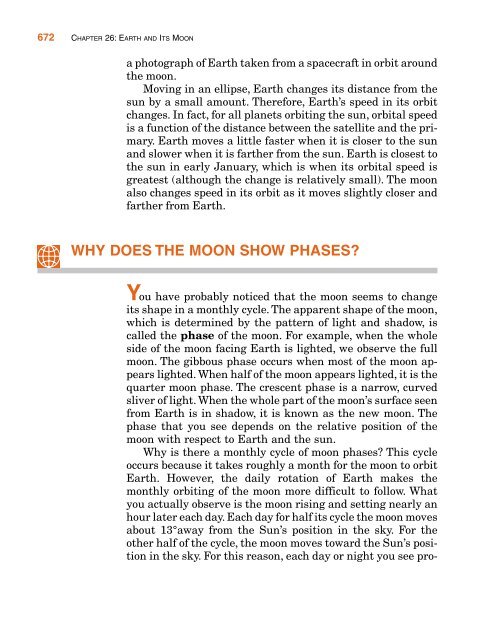Chapter 26 Earth and Its Moon
Chapter 26 Earth and Its Moon
Chapter 26 Earth and Its Moon
Create successful ePaper yourself
Turn your PDF publications into a flip-book with our unique Google optimized e-Paper software.
672 CHAPTER <strong>26</strong>: EARTH AND ITS MOON<br />
a photograph of <strong>Earth</strong> taken from a spacecraft in orbit around<br />
the moon.<br />
Moving in an ellipse, <strong>Earth</strong> changes its distance from the<br />
sun by a small amount. Therefore, <strong>Earth</strong>’s speed in its orbit<br />
changes. In fact, for all planets orbiting the sun, orbital speed<br />
is a function of the distance between the satellite <strong>and</strong> the primary.<br />
<strong>Earth</strong> moves a little faster when it is closer to the sun<br />
<strong>and</strong> slower when it is farther from the sun. <strong>Earth</strong> is closest to<br />
the sun in early January, which is when its orbital speed is<br />
greatest (although the change is relatively small). The moon<br />
also changes speed in its orbit as it moves slightly closer <strong>and</strong><br />
farther from <strong>Earth</strong>.<br />
WHY DOES THE MOON SHOW PHASES?<br />
You have probably noticed that the moon seems to change<br />
its shape in a monthly cycle. The apparent shape of the moon,<br />
which is determined by the pattern of light <strong>and</strong> shadow, is<br />
called the phase of the moon. For example, when the whole<br />
side of the moon facing <strong>Earth</strong> is lighted, we observe the full<br />
moon. The gibbous phase occurs when most of the moon appears<br />
lighted. When half of the moon appears lighted, it is the<br />
quarter moon phase. The crescent phase is a narrow, curved<br />
sliver of light. When the whole part of the moon’s surface seen<br />
from <strong>Earth</strong> is in shadow, it is known as the new moon. The<br />
phase that you see depends on the relative position of the<br />
moon with respect to <strong>Earth</strong> <strong>and</strong> the sun.<br />
Why is there a monthly cycle of moon phases? This cycle<br />
occurs because it takes roughly a month for the moon to orbit<br />
<strong>Earth</strong>. However, the daily rotation of <strong>Earth</strong> makes the<br />
monthly orbiting of the moon more difficult to follow. What<br />
you actually observe is the moon rising <strong>and</strong> setting nearly an<br />
hour later each day. Each day for half its cycle the moon moves<br />
about 13°away from the Sun’s position in the sky. For the<br />
other half of the cycle, the moon moves toward the Sun’s position<br />
in the sky. For this reason, each day or night you see pro-

















